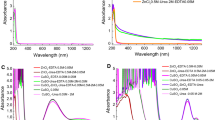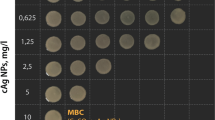Abstract
This study opens the investigation series focused on antimicrobial effects of copper (Cu) compared to silver (Ag), which is currently used to treat wound infection in burn victims as well as in chronic wounds. Noticeably, in its ionized state, Cu is more commonly present as Cu2+ rather than as Cu+, while electronic configuration similarity of Cu+ and Ag+ indicates that actually it may be the active state. To test this hypothesis, effect of Cu+ and Cu2+, using Ag+ ions and metallic copper as controls on Escherichia coli and Staphylococcus aureus bacteria, was examined under anaerobic conditions. Cu+ was produced by two different methods, and its effect on microorganism growth was tested using a syringe and Petri dish methods. It was found that the presence of Cu+ causes a dramatic depletion in the viability of both microorganisms. Metallic copper did not have any effect on the viability, whereas Cu2+ and Ag+ ions had much lower activity than Cu+ ions. Minimal inhibitory concentration of Cu+ for E. coli was twice lower than that of Cu2+. The obtained results show that Cu+ proves to be a potent antimicrobial agent.

Similar content being viewed by others
References
Abboud EC, Settle JC, Legare TB, Marcet JE, Barillo DJ, Sanchez JE (2014) Silver-based dressings for the reduction of surgical site infection: review of current experience and recommendation for future studies. Burns 40 Suppl 1:S30–S39. https://doi.org/10.1016/j.burns.2014.09.011
Borkow G, Gabbay J (2009) Copper, an ancient remedy returning to fight microbial, fungal and viral infections. Curr Chem Biol 3(3):272–278
Casey AL, Karpanen TJ, Adams D et al (2011) A comparative study to evaluate surface microbial contamination associated with copper-containing and stainless steel pens used by nurses in the critical care unit. Am J Infect Control 39(8):e52–e54
Dollwet H, Sorenson J (1985) Historic uses of copper compounds in medicine. Trace Elem Med 2(2):80–87
Espirito Santo C, Lam EW, Elowsky CG et al (2011) Bacterial killing by dry metallic copper surfaces. Appl Environ Microbiol 77(3):794–802
Grass G, Rensing C, Solioz M (2011) Metallic copper as an antimicrobial surface. Appl Environ Microbiol 77(5):1541–1547
Karpanen TJ, Casey AL, Lambert PA et al (2012) The antimicrobial efficacy of copper alloy furnishing in the clinical environment: a crossover study. Infect Control Hosp Epidemiol 33(1):3–9
Macomber L, Imlay JA (2009) The iron–sulfur clusters of dehydratases are primary intracellular targets of copper toxicity. Proc Natl Acad Sci USA 106(20):8344–8349
Macomber L, Rensing C, Imlay JA (2007) Intracellular copper does not catalyze the formation of oxidative DNA damage in Escherichia coli. J Bacteriol 189(5):1616–1626
Mehtar S, Wiid I, Todorov S (2008) The antimicrobial activity of copper and copper alloys against nosocomial pathogens and Mycobacterium tuberculosis isolated from healthcare facilities in the Western Cape: an in-vitro study. J Hosp Infect 68(1):45–51
Mikolay A, Huggett S, Tikana L et al (2010) Survival of bacteria on metallic copper surfaces in a hospital trial. Appl Microbiol Biotechnol 87(5):1875–1879
Noyce JO, Michels H, Keevil CW (2007) Inactivation of influenza A virus on copper versus stainless steel surfaces. Appl Environ Microbiol 73(8):2748–2750
O’Gorman J, Humphreys H (2012 Aug) Application of copper to prevent and control infection. Where are we now? J Hosp Infect 81(4):217–223
Parker AJ (1973) Copper ions in acetonitrile. Search 4:426
Parker AJ, Macleod ID, Singh P (1981) Electrochemistry of copper in aqueous acetonitrile. J Solut Chem 10(11):757–774
Santo CE, Quaranta D, Grass G (2012) Antimicrobial metallic copper surfaces kill Staphylococcus haemolyticus via membrane damage. Microbiologyopen 1(1):46–52. https://doi.org/10.1002/mbo3.2
Saphier M, Burg A, Sheps S, Cohen H, Meyerstein D (1999) Complexes of copper(I) with aromatic compounds in aqueous solutions. J Chem Soc Dalton Trans 11:1845–1849
Stout JE, Yu VL (2003) Experiences of the first 16 hospitals using copper–silver ionization for Legionella control: implications for the evaluation of other disinfection modalities. Infect Control Hosp Epidemiol 24(8):563–568
Warnes SL, Keevil CW (2011) Mechanism of copper surface toxicity in vancomycin-resistant enterococci following wet or dry surface contact. Appl Environ Microbiol 77(17):6049–6059
Weaver L, Michels HT, Keevil CW (2010) Potential for preventing spread of fungi in air-conditioning systems constructed using copper instead of aluminium. Lett Appl Microbiol 50(1):18–23
Weaver L, Noyce JO, Michels HT, Keevil CW (2010) Potential action of copper surfaces on meticillin-resistant Staphylococcus aureus. J Appl Microbiol 109(6):2200–2205
Author information
Authors and Affiliations
Corresponding author
Ethics declarations
Conflict of interest
The authors declare that there is no conflict of interest
Rights and permissions
About this article
Cite this article
Saphier, M., Silberstein, E., Shotland, Y. et al. Prevalence of Monovalent Copper Over Divalent in Killing Escherichia coli and Staphylococcus aureus . Curr Microbiol 75, 426–430 (2018). https://doi.org/10.1007/s00284-017-1398-4
Received:
Accepted:
Published:
Issue Date:
DOI: https://doi.org/10.1007/s00284-017-1398-4




